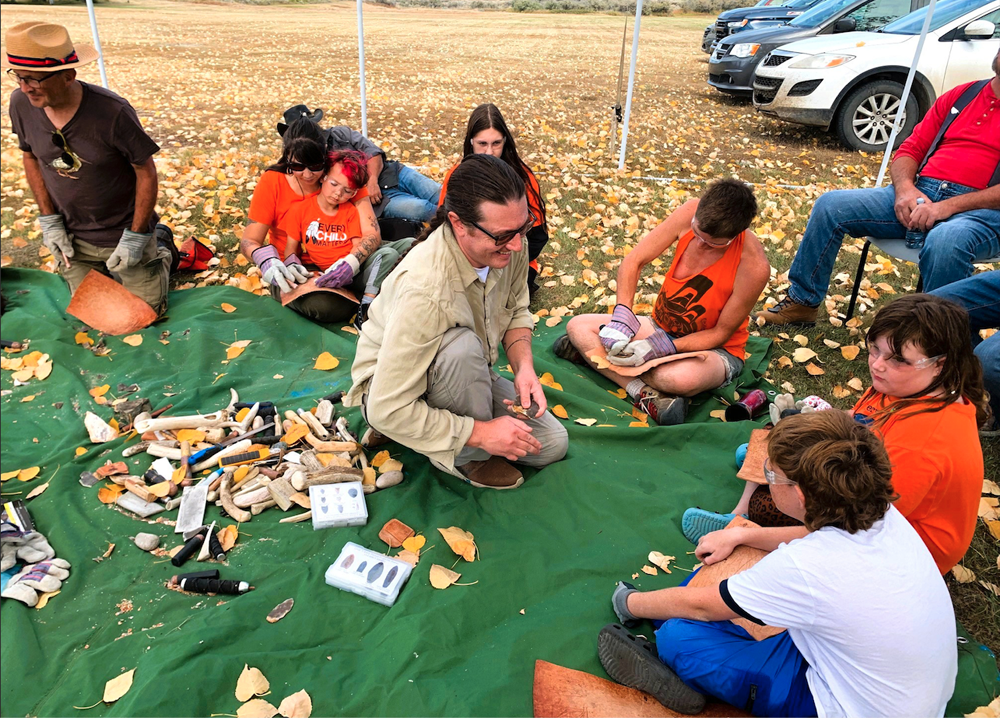Community event promotes reconciliation and Indigenous culture
Posted on October 15, 2025 by Ryan Dahlman
Marina Gryde, Curator, Climax Community Museum
The weather was warm and bright on Sept. 30 for National Day for Truth and Reconciliation and Orange Shirt Day held in the historic Whitemud River Valley between Climax and Shaunavon. The celebration was part of Climax Hub Culture Days, funded by SaskCulture in partnership with Sask Lotteries.
The Frenchman Valley, known to locals as the Whitemud, was alive with Indigenous presenters from Maple Creek, Swift Current, Saskatoon and Fort Belknap, MT and with attendees from Val Marie, Shaunavon, Eastend, Claydon, Frontier, Bracken and Climax. Participants also included a paleontologist, historians from Eastend and biologists and staff from Grasslands National Park who brought their families, along with two SaskCulture representatives from Regina who conducted on-site interviews.
Nekaneet Knowledge Keeper Clarence Oakes accompanied by Yvonne Mosquito and Anne Wesaquate offered a welcome prayer in Plains Cree language, and spoke on Nekaneet history, treaties, and the cultural impacts of the residential school system. Anne displayed beaded keychains and dream catchers on a buffalo hide shown beside a large ceremonial elk hide drum.
Sylvia Thorburn, a presenter in Chinook School, Swift Current from Beardy’s & Okemasis First Nation brought beading, colourful ribbon skirts, medicine bags and pow wow music. Sylvia’s delicious fry bread and bannock were enjoyed along with a barbeque lunch as people settled down to watch Singing Back the Buffalo, the award-winning documentary by Dr. Tasha Hubbard, associate professor at the University of Alberta, and film producer George Hupka of Downstream Pictures which detailed Indigenous efforts to restore the buffalo as a cultural healer and keystone species to historic natural Indigenous sites. Dr. Hubbard noted she viewed the screening “as a vision of true reconciliation.”
After the film Dr. Sean Chandler, a member of the International Buffalo Relations Board and signatory to the Buffalo Treaty, was available to answer questions.
As a Aaniiih language teacher and president of Aaniiih Nakoda College, Fort Belknap, MT Dr Chandler is also an accomplished artist who’s exhibited in the MacKenzie Art Gallery in Regina and in numerous Montana galleries. He spoke on the early history of Aaniiih (White Clay People/Gros Ventre) in Canada, migration to the U.S., the impact of U.S. boarding schools, and how facing racism and celebrating Aaniiih cultural expression through art, language and education at Aaniiih Nakoda College brings healing and renewal.
Eastend amateur historian John Schmitt, who’s spoken on the Aaniiih’s habitation of the Whitemud, noted that he was especially interested and grateful for Dr. Chandler’s presentation.
Gabriel Essaunce Lamarche, an Ojibway archeologist from Beausoleil First Nation (Ontario), shared his knowledge of ancestral tools, based on scientific study of archaeological sites and artifacts found in Saskatchewan and elsewhere in Canada.
Participants learned about their traditional use and about the sophisticated skill needed to shape, temper and utilize stone tools for maximum effect. “Not only did/does it require a deep understanding of stone material properties and geometry, but also knowledge of the animals being hunted; their physiology, ethology and bio-geography” noted Lamarche.
Grouped in a circle, participants examined ancient stone spear points and arrowhead styles that were scientifically excavated in Saskatchewan; some up to 13,000 years old. Each individual was guided on basic fracturing techniques of flint-knapping and made their own projectile points: arrow heads or spear heads. Some even tested them out in target shooting on site!
Sharon Girard from Eastend Historical Museum brought arrowheads from their collection and was thrilled to learn the age, source, properties, type of stone, and how they were constructed and tempered. Gabriel noted that some were indicative of the longstanding trade history among Indigenous peoples, as evidenced by arrowheads and tools that were constructed of stone not found in these parts, but from North Dakota, Minnesota and Eastern Canada.
The Chinook Library, Climax branch featured books for National Day for Truth and Reconciliation including the Saskatchewan Archaeological Society’s award-winning book, “Point of View: A Guide on Saskatchewan Projectile Points with Indigenous Perspectives” of which Gabriel was a contributor.
Gabriel, who’s role as a Repatriation and Community Liaison for Museum Association of Saskatchewan, teaches in communities and schools about pre-contact Indigenous tool manufacturing techniques and was scheduled to visit Frontier School and The Grand Coteau Heritage Centre for Culture Days.
Culture Days events like these enable us to bring people together in the spirit of learning and reconciliation; it’s where we connect personally. Today we’ve experienced a deeper appreciation of the ingenuity wisdom and skill of Indigenous tool makers, beaders, Knowledge Keepers, storytellers, writers, advocates, educators and film makers. Thanks to funding from SaskCulture in partnership with Sask Lotteries and an interview on CBC Saskatchewan Morning Edition and the Shaunavon Standard the Climax Community Museum was able to inform more people about the day’s events in the Whitemud.
We are grateful to all who presented, attended, engaged, sponsored and volunteered and we look forward to future events. As Phyllis Webstad, founder of Orange Shirt Day noted “Listening is a first step towards reconciliation; it’s never too early to start.”
Leave a Reply
You must be logged in to post a comment.

